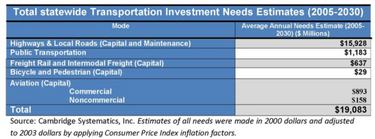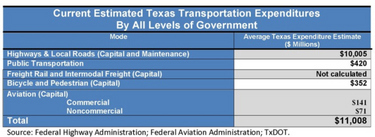
"Grover’s Tub: ' Pit Bulls on the Turnpike"
January 7, 2010
Right after World War II, with 12 million men and women home from war and looking for work, President Franklin Roosevelt appointed a National Highway Committee to develop plans for a national system of expressways. Congress designated the 40,000-mile National System of Interstate Highways in 1944, but it was not funded until President Dwight Eisenhower made it a cornerstone of his domestic agenda in 1956.
Written by Senator Eliot Shapleigh, www.groverstub.com
Right after World War II, with 12 million men and women home from war and looking for work, President Franklin Roosevelt appointed a National Highway Committee to develop plans for a national system of expressways. Congress designated the 40,000-mile National System of Interstate Highways in 1944, but it was not funded until President Dwight Eisenhower made it a cornerstone of his domestic agenda in 1956.
Right after World War II, with 12 million men and women home from war and looking for work, President Franklin Roosevelt appointed a National Highway Committee to develop plans for a national system of expressways. Congress designated the 40,000-mile National System of Interstate Highways in 1944, but it was not funded until President Dwight Eisenhower made it a cornerstone of his domestic agenda in 1956.
After more than 50 years, Eisenhower’s plan has become the most successful public works project in our nation’s history. With over 42,000 miles built, at a cost of $128.9 billion, the highway system put millions of WWII service men and women back to work, and provided the infrastructure for the movement of people and products that fuels our economy today. Gas tax at the pump paid for highways from ports to plains.
In Texas, 77,000 miles of state and federal highways have been constructed since the Texas Highway Department was created in 1917. Our road and bridge system was once described as the crown jewel of the 50 states. But after fifteen long years of Grover Norquist-style leadership, Texas highways are now a mess.
Nearly a quarter of a century ago, a handful of lawmakers embraced this philosophy, calling themselves the “Pit Bulls." They set out to cut taxes for the wealthy, and then cut budgets for Texas. One key mantra of the Pit Bulls was to privatize whatever government function or service possible. Years later, dozens of House members signed the Norquist pledge to “never raise taxes.” Two of these Pit Bulls were Rick Perry and the late TxDOT Commission Chairman, Ric Williamson.
Today, years after the Pit Bulls first pledged to “drown” government, the Texas highway system is itself under water.
In a recent report, titled “Moving Texas to the 21st Century,” Cambridge Systematics, a leading U.S. consulting group on infastructure, reported that Texas highway funds are at least $8 billion short each year from meeting the basic needs of a growing state.
Here below, in Chart 1, you can see how much Texas needs to spend to build the transportation and infrastructure we need:
Click here to view larger image.
Chart 2 shows how much money we actually have:
Click here to view larger image.
With Texas set to grow up to 49 million inhabitants by 2050, we are $256 billion short of meeting mobility needs, or $8 billion each year. Remember, basic infrastructure is the key to a competitive economy—without the ability to move people and products, manufacturers and others will go to states and countries that can.
What happened here? Diversion happened. Grover’s disciples diverted highway money to pay for other budget needs. Approximately $2.9 billion of gas tax money designated for roads is diverted every biennium to pay for “other services.” For example, $1.144 billion goes to fund the Department of Public Safety, and another 25% of the gas tax goes to pay for public schools. Another $100 million goes toward buying helicopters and other equipment to patrol border counties, and even the Commission of the Arts gets $1.34 million. Over 10 years, more than $11.2 billion has been diverted from the highway fund to pay for other things.
Shackled by their no-new tax pledge, Norquist’s Pit Bulls rob from Peter to pay Paul. Without courage to identify clear needs, raise revenues and fund the basic needs of a growing state, they simply rearrange the deck chairs using existing revenues. And that’s why Texas highways are in Grover’s tub today.
Privatization is not the answer, as Norquist’s disciples would have us believe. In Texas, the privatizers want to lease our highways for up to 50 years, using the toll money paid by taxpayers to fund the deal. What they don’t tell you, is that toward the end of the lease, private tolls can cost as much as $15 dollars for ten miles and that millions in revenue for real estate development, mineral rights, even energy transmission will go to foreign companies like CINTRA, who will control our highways until 2056. Highways will no longer be run for the public good—but for private gain.
During the 81st legislative session, a bi-partisan coalition of legislators took a close look at how to fish Texas out of Grover’s tub. A diverse group of committed Senators, including John Carona (R-Dallas), Kirk Watson (D-Austin), Jeff Wentworth (R-San Antonio), Rodney Ellis (D-Houston), and Florence Shapiro (R-Dallas) dedicated their expertise and many hours to solving this challenge. The Texas Senate passed S.B. 855, a bill that would have allowed local governments to raise funds for new road and rail projects. S.B. 855 would have given urban areas the option to call an election for voters to decide whether to approve new funding from three revenue options for roads and railways.
Already running right in the Republican primary, both Rick Perry and Lt. Governor David Dewhurst bent to pressure from Norquist groups and made it abundantly clear that they would not support any legislation that would raise taxes or fees, even if it was up to the voters to decide in local elections. As a result, S.B. 855 died in the House without even a roll call vote.
Under the budget passed by the 81st Legislature, TxDOT will receive $270 million for new construction in 2010 and $590 million in 2011. Gas tax revenues through June 2009 are down 2.6 percent from the year before. Federal highway funds have seen a 4.1 percent reduction from fiscal year 2008. Inflation from higher concrete and steel caused highway construction costs to rise 60 percent between 2002 and 2007. Despite Rick Perry’s pledge to stop diversions, only $65 million out of $2.9 billion in biennial diversions was done in the 81st Legislative Session.
It’s going to take courage and leadership to fix this problem and get Texas back on track. With a mix of new revenues, local, state and federal, with increasing attention to mobility by mile by mode, (including downtown trolleys, commuter rail, and intermodal hubs) with innovative ideas like energy producing highways, our great state can meet the challenge.
Now, more than ever, we need to set aside the failed philosophy of Grover Norquist and get Texas moving once again.
![]()
Fair Use Notice
This site contains copyrighted material the use of which has not always been specifically authorized by the copyright owner. We are making such material available in our efforts to advance understanding of environmental, political, human rights, economic, democracy, scientific, and social justice issues, etc. We believe this constitutes a "fair use" of any such copyrighted material as provided for in section 107 of the US Copyright Law. In accordance with Title 17 U.S.C. Section 107, the material on this site is distributed without profit to those who have expressed a prior interest in receiving the included information for research and educational purposes. For more information go to: http://www.law.cornell.edu/uscode/17/107.shtml. If you wish to use copyrighted material from this site for purposes of your own that go beyond "fair use", you must obtain permission from the copyright owner.

